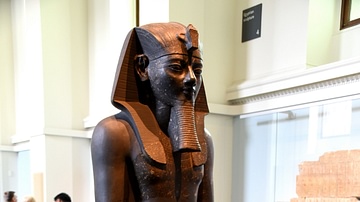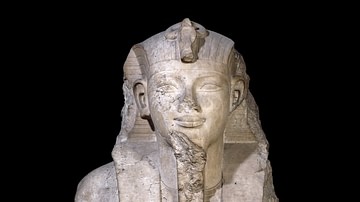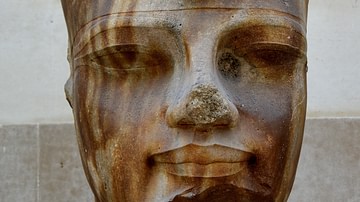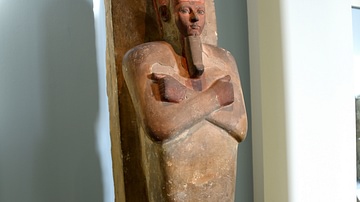Illustration
Statue of Amenhotep III, declares the king's might by representing him as a lion, from Napata (Gebel Barkal, Sudan), originally from Soleb (Sudan), 18th Dynasty, reign of Amenhotep III, 1390-1352 BCE.
Pharaohs were often shown as a sphinx, with the body of a lion, but the full lion image is rare. An inscription on the chest, added by Amenhotep IV, calls the king a "lion of the rulers, wild when he sees his enemies tread his path". The sculpture was famed for its realistic anatomical detail and departure from the frontality of most Egyptian statues. The eyes were originally inlaid. Amenhotep III commissioned the lion sculptures for the temple of Amun-Ra at Soleb in Upper Nubia, in the conquered former kingdom of Kush. The next king, Amenhotep IV (later called Akhenaten), ensured that these sculptures reached Soleb, after his father's untimely death. In the text on the base, Amenhotep is honored by his grandson, Tutankhamun. A thousand years later, the statues so impressed the Kushite ruler, Amanislo, that her moved them 500 kilometers south to the city of Napata. Here, Amanislo's name appear on the lion's left foreleg.
The British Museum, London.
About the Author
Cite This Work
APA Style
Amin, O. S. M. (2016, July 18). King Amenhotep III as a Lion. World History Encyclopedia. Retrieved from https://www.worldhistory.org/image/5368/king-amenhotep-iii-as-a-lion/
Chicago Style
Amin, Osama Shukir Muhammed. "King Amenhotep III as a Lion." World History Encyclopedia. Last modified July 18, 2016. https://www.worldhistory.org/image/5368/king-amenhotep-iii-as-a-lion/.
MLA Style
Amin, Osama Shukir Muhammed. "King Amenhotep III as a Lion." World History Encyclopedia. World History Encyclopedia, 18 Jul 2016. Web. 15 Apr 2025.








